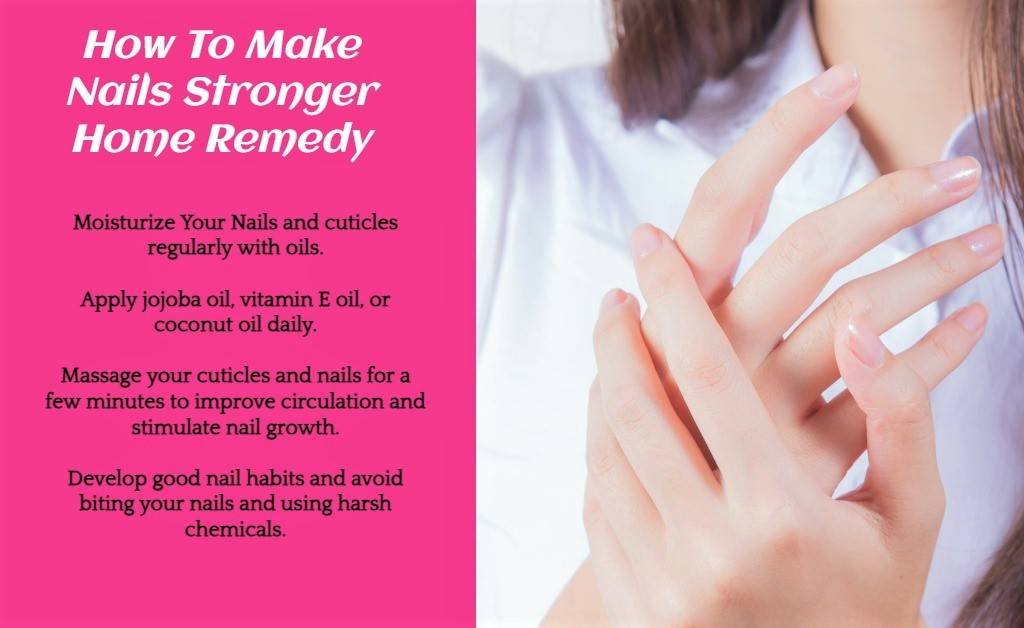If you want to refresh your acrylic nails but don’t have time for a salon visit, removing them at home without acetone is possible with a few simple tools. First, use an orange stick to gently lift and loosen the acrylic from the sides of your real nails. This helps break the seal so the rest slides off smoothly. Next, apply an acetone-free nail polish remover to the tips of the nails and underneath where they are still attached to the skin. Massage it in to dissolve the bonding agent.
You can also soak cotton balls in the remover and place them on top if they aren’t budging. Be patient and persistent – the acrylic will soften within 10-15 minutes without damaging your natural nails. Once completely loosened, the nails should slide right off. Finish by cleaning any remaining residue with the orange stick. Your real nails will thank you for avoiding harsh acetone!
How to Take Off Acrylic Nails Without Acetone
Acrylic nails can be a fun way to strengthen and lengthen your natural nails, but removing them at home without damaging your nails can be challenging. Acetone is a harsh chemical found in most nail polish removers and the primary method used in salons to dissolve acrylic nails.

However, acetone can dry out and weaken your nails. The good news is there are several acetone-free methods you can try to safely remove acrylic nails at home. In this article we will discuss how to take off acrylic nails without acetone at home naturally without taking any damage to your nails.
Soak Off Methods To Take Off Acrylic Nails Without Acetone
Please follow the methods given below to remove acrylic nails at home safely and naturally without any damage.
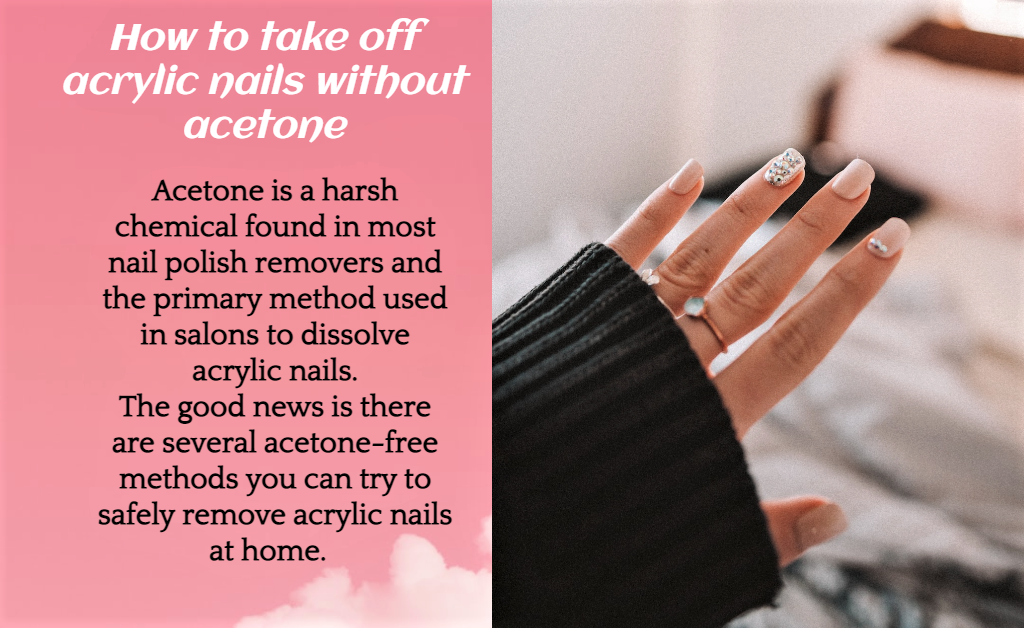
Remove Acrylic Nails Using Nail Polish Remover Pads
Soak Off Method Using Nail Polish Remover Pads
Remove acrylic nails without acetone by using non-acetone nail polish remover pads are a gentle alternative to harsh acetone and one of the most effective ways to remove acrylic nails without damaging your natural nails. Here are the steps to remove acrylic nails without acetone by using nail polish remover pads:

- File down the acrylic to remove the topcoat sealant. Use a nail file to gently file down and rough up the surface of the acrylic nails. This will allow the nail remover to penetrate the acrylic. Do not file into your natural nail.
- Wrap each nail in a remover pad. Take a non-acetone remover pad and wrap one around the base of each acrylic nail. Secure in place with aluminum foil or bandages.
- Soak for 15-20 minutes. Keep your nails wrapped for at least 15 to 20 minutes to allow the pads ample time to soften the acrylic.
- Gently pry off the acrylic. After soaking, the acrylic should come off fairly easily using a wooden or rubber nail pick. Gently work the pick underneath the edge of the acrylic and pry up slowly and evenly on both sides. Do small sections at a time to avoid cracking the acrylic. The acrylic should come off in large, soft pieces without damaging your natural nail.
- Use a nail brush to remove any remaining residue. Gently brush your natural nails with a soft nail brush to remove any remaining acrylic dust and residue. Moisturize your nails and the surrounding skin when done.
Repeat the soaking and prying process if any acrylic remains. Be patient and take your time to avoid peeling or cracking the acrylic. With consistent soaking, the acrylic will soften sufficiently for easy removal without damage.
Remove Acrylic Nails Using Warm Water
Soak Off Method Using Warm Water
Remove acrylic nails without acetone by using warm water soak that is another effective way to soften acrylic nails for easy, damage-free removal at home. Here are the steps remove acrylic nails without acetone by using warm water:

- File the acrylic surface. Gently file down the top layer of the acrylic nails to rough up the surface and allow water to penetrate. Do not file into the natural nail.
- Soak your nails in warm water. Submerge your nails in a bowl of warm water for 15 to 20 minutes. The water should be warm but comfortable, around 95 to 105 degrees Fahrenheit.
- Gently pry off the acrylic. After soaking, the acrylic should be very soft and pliable. Gently slide a wooden or rubber nail pick under the edge of the acrylic and slowly pry up and away from your natural nail. Work slowly in small sections on both sides of the nail. The acrylic should come off in large, softened pieces with minimal effort and no damage.
- Remove remaining residue and moisturize. Use a soft nail brush to gently remove any remaining acrylic residue from your natural nails. Apply a moisturizer and cuticle oil to hydrate your nails and the surrounding skin.
You may need to repeat the soaking and prying process a few times to fully remove the acrylic. Be gentle and patient to avoid cracking or peeling the acrylic. With consistent soaking, the acrylic will get very soft and can be pried off without harming your natural nails. The key is long enough soaking time in warm water.
Remove Acrylic Nails Using Dental Floss
Using Dental Floss
Remove acrylic nails without acetone by using dental floss is another useful tool for removing acrylic nails without harsh chemicals. Here is the method remove acrylic nails without acetone:
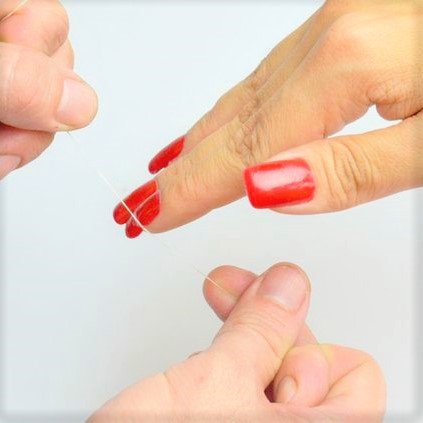
- File the acrylic surface. Gently file down the top layer of the acrylic to rough up the surface and allow the floss to grip underneath the acrylic edge. Do not file into your natural nail.
- Thread dental floss under the acrylic edge. Carefully slide a piece of dental floss under the edge of the acrylic nail using a floss threader or needle. Move slowly to avoid snapping the floss.
- Gently saw back and forth. Holding both ends of the floss, use a gentle seesaw motion to move the floss back and forth under the acrylic. Apply firm and even pressure as you saw through the acrylic. This will weaken the bond from your natural nail without damage.
- Pry off the acrylic. Once you have threaded and sawed through most of the acrylic, you should be able to gently pry it off with a wooden or rubber nail pick. Start at the edge where you threaded the floss and work around the sides of the nail using small, even pressure. The acrylic should come off without issue. Repeat on any remaining nails.
- Remove residue and moisturize. Use a soft nail brush to clean underneath your natural nails and remove any remaining acrylic dust. Apply a rich moisturizer and cuticle oil to hydrate your nails after removing the acrylic.
Be very gentle while using the dental floss and filing to avoid weakening or cracking your natural nails. With patience and consistency, the dental floss method can be effective for removing acrylics at home without acetone. Moisturizing your nails after removal is key to preventing damage.
Summary
In summary, there are several acetone-free methods you can use to safely remove acrylic nails without acetone at home. Non-acetone nail polish remover pads, warm water soaking, and dental floss are all effective options for softening and removing acrylics without causing damage to your natural nails. Be gentle, take your time, file lightly and avoid over-filing, and keep your nails well hydrated for the healthiest natural nails after acrylic removal. With time and practice, you can become a pro at painlessly removing your acrylics at home without harsh chemicals.
Tips to remove acrylic nails off without acetone

Use petroleum jelly to loosen the acrylic bonds
Apply petroleum jelly or olive oil around the cuticle area and underneath the edge of the acrylic nails. Let it sit for several minutes to help loosen the acrylic from your natural nails before using other removal methods. The oil will help weaken the acrylic adhesion for easier removal.
Try an acrylic nail remover alternative
Commercial acrylic nail removal alternative products contain chemical solvents to dissolve the acrylic without acetone. Follow the directions to file the acrylic, apply the product and let it soak in, then gently pry off the acrylic after the recommended time. These alternatives still contain harsh chemicals, so moisturize your nails thoroughly after use.
Use nail nippers and nail clippers
For stubborn acrylic nails, sterilized nail nippers and nail clippers can be useful for clipping and prying off remaining pieces of softened acrylic during the removal process. Soak the acrylic first to soften before clipping and prying with tools. Be very careful not to pinch or crack your natural nails.
Apply cuticle softener
A cuticle softener product containing jojoba oil or keratin can help soften the area between your natural nail and acrylic nail, making the acrylic easier to remove. Gently push back your cuticles and apply the softener prior to using a removal method.
Let your nails rest
Avoid reapplying acrylic or any other nail products for at least a week after removal. Your natural nails need sufficient time to recover moisture and strength. Keep them hydrated with a rich moisturizer and nail oil and avoid water exposure as much as possible.
See a dermatologist if nails are damaged
See a dermatologist or nail specialist if your nails become damaged, infected or irritated from acrylic removal. They may need to be treated to avoid permanent damage or loss. It is best to have acrylics removed by a nail technician to prevent potential harm.
Habitual use of acrylic can lead to nail damage
Get acrylic nails only for special occasions to avoid long term damage and weakening of your natural nails. Your nails need time between acrylic applications to recover.
With patience and proper care, you can remove acrylic nails without acetone without causing lasting damage. However, for persistent or problematic nails, it is best to see a dermatologist or nail salon technician to avoid risks to your natural nail health and have the acrylics properly removed. Limiting the frequency of acrylic use will also help promote stronger, healthier nails over time.
Conclusion
In conclusion, remove acrylic nails without acetone can be challenging but with the proper tools and technique, it is possible to do safely at home. Methods such as non-acetone nail polish remover pads, dental floss, warm water soaking and using natural oils help weaken the bonds of the acrylic from your nails for easy, damage-free removal. Also visit it you like to to take off dip powder nails without acetone. and grow nails stronger and faster at home.
FAQs
How to take off acrylic nails at home fast without acetone?
To take off acrylic nails at home fast without acetone use non-acetone nail polish remover pads, warm water soaking, and dental floss are all effective options for softening and removing acrylics without causing damage to your natural nails.
How to take off acrylic nails without acetone?
To remove acrylic nails without acetone use non-acetone nail polish remover pads, warm water soaking, and dental floss are all effective options for softening and removing acrylics without causing damage to your natural nails.
how to remove acrylic nails with nail polish remover pads?
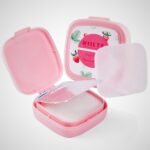
Remove acrylic nails without acetone by using non-acetone nail polish remover pads are a gentle alternative to harsh acetone and one of the most effective ways to remove acrylic nails without damaging your natural nails.
How to take off acrylic nails with warm water?
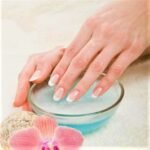
Remove acrylic nails without acetone by using warm water soak that is another effective way to soften acrylic nails for easy, damage-free removal at home. File the acrylic surface. Gently file down the top layer of the acrylic nails to rough up the surface and allow water to penetrate.
Can I soak my acrylic nails in hot water to remove them?

No, hot or boiling water can cause burns and permanent nail damage. Use warm water between 95 to 105 degrees Fahrenheit for soaking acrylic nails.
Is it better to have a nail salon to remove my acrylic nails?
For most people, having acrylic nails removed by a nail professional at a salon is safer and prevents potential damage. Nail technicians have the proper tools, training and experience to remove acrylics without harming your natural nails. However, if you take your time and are very gentle, it is possible to remove acrylics yourself at home without damage using non-acetone methods.
How long does it take for natural nails to recover from acrylic use?
Natural nails require at least 3 to 4 weeks to get fully recover from acrylic application and removal. Avoid reapplying acrylics or any harsh polishes during this time. Moisturize your nails and cuticles daily to aid the recovery process. Limiting how often you get acrylics will also promote long term nail health and strength.
Is there an easier way to remove acrylic nails at home without damage?

Non-acetone nail polish remover pads tend to be the easiest and most effective way to remove acrylic nails at home without damage. Soak the pads in remover and wrap around the nails to soften the acrylic, gently pry off after 15 to 20 minutes. The remover and soaking action does most of the work for you. Be patient and take your time. Other methods require more manual manipulation which can lead to potential damage if not done properly. Moisturize thoroughly after removal.
What can I do if my nails are damaged after removing acrylics?
If your nails show signs of damage like peeling, breaking, discoloration or irritation after removing acrylics, treat them with a nail repair treatment. Apply a nail moisturizer and cuticle oil 3 times a day to hydrate your nails and the skin around them. Take a biotin supplement to promote nail growth and strength. Avoid any nail polish or acrylic products for at least 2 weeks. See a dermatologist if your nails become severely damaged or infected. They may need medical treatment to prevent permanent harm or loss.


